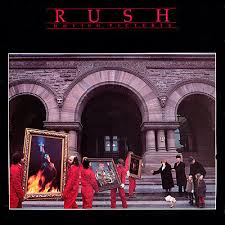20 Rush Albums in 20 Days: Moving Pictures
 DAY THREE: Rush, Moving Pictures, running time 40:02, released February 12, 1981
DAY THREE: Rush, Moving Pictures, running time 40:02, released February 12, 1981
So here it is, what many consider to be Rush’s best effort, the album the band themselves played in its entirety throughout their 2010-2011 tour. Moving Pictures. So the questions is: does it hold up?
Um…yeah. Or…at least half of it does. Part of it is a masterpiece. And yet…
Upon listening to it front to back, the first thing that struck me – especially after listening to Hold Your Fire and Presto the previous two days – is just how clean and uncluttered Moving Pictures sounds. The band was still very much insistent on recording what they could reproduce live, and the result is a crisp mix in which each instrument shines brightly. Consider Lifeson’s solo on the opening track, “Tom Sawyer.” Whereas in later years Rush would have added a keyboard part and two additional guitar tracks to emphasize certain moments, here we get the band at its most basic best: a well-executed solo over the clean bass sound of Geddy Lee and the brilliantly recorded “snap” of Peart’s drums. Perfect. I’ve heard that Rush were influenced by The Police, and though the music is of course completely different, I can see how the production on Moving Pictures might have been inspired by albums like Outlandos d'Amour and Reggatta de Blanc.
The first side of Moving Pictures is among the best twenty minutes ever recorded. It has the band’s best instrumental (“YYZ”), among its most melodic songs (“Limelight”), the most identifiable and spirited story (“Red Barchetta”) and, of course, what many believe is the band’s quintessential track (“Tom Sawyer”). My friend and I used to make fun of Lifeson’s wailing guitar solo in “Limelight,” thinking it completely out of character with the rest of the tune. Now I think it’s a stroke of genius. I guess thirty-three years can do that to one’s perspective.
Not so with Lifeson’s work on the closing track of the album, “Vital Signs.” Here his guitar choices are sloppy and uncertain – not to mention overbearing – almost as if he didn’t know what to do with this foreshadowing of the direction Rush would travel over the next four albums with keyboards taking center stage. Lifeson would evolve into this role nicely over the next decade. Here he’s still finding his legs, and the song suffers as a result.
During side two, I enjoyed “The Camera Eye” despite the dated synthesizers, though it does go on too long. Then I got to “Witchhunt,” a track that for me surprisingly labored under the weight of self-importance and overall drudgery. I couldn’t help but picture Spinal Tap parodying the first verse of this song: The night is black without a moon/The air is thick and still/The vigilantes gather on/The lonely torch lit hill. Christopher Guest could have worked wonders with this tune, along with a dancing witch galloping around a black cauldron. Can’t you picture it?
These are minor quibbles. Moving Pictures is an excellent album. Perhaps not as perfect as I remember it, but damn good. It should not go unnoticed that this album runs at just over forty minutes. Countless bands would do well to remember that the greatest albums ever recorded stop at around the forty minute mark (or well before). If Rush had recorded this album just six years later, they would have added two additional tracks, likely encumbering the overall package. Less is sometimes more. Just because you can fill 60-70 minutes of a CD doesn’t mean you should (when Aerosmith started releasing albums lasting over an hour – 1993’s Get A Grip – you just knew that things had gone too far).
Tomorrow, I’ll be listening to…drum roll, please…number 2. Talk about a stylistic change! Fly by Night is on the docket for tomorrow (only 37 minutes long, too!). Can’t wait.